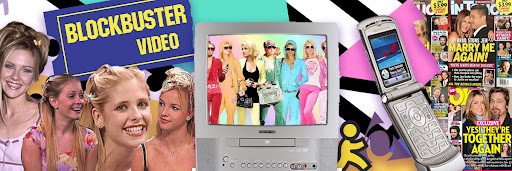It’s time to take a trip down memory lane, back to the days of glittery and painful MySpace profile customizations, top 8 friends, and soaking up every Dave Matthews Band song you could — the early 2000s! At the time, it felt like we’d never outgrow these trends, but alas, the early 2000s have come and gone, and now here we are looking back on them with nostalgia.
Let us take you back to the sweet sound of a dial-up connection.
Remembering old social media websites is like a time machine into the past. Before the emergence of platforms such as Twitter, Facebook, Instagram, Snapchat, and TikTok, many of us were guilty of some cringe-worthy escapades on social media that we’d prefer to wipe from the internet. Join us on a trip down memory lane as we explore the humble beginnings of social media.
MySpace
Do you ever have those moments of absolute horror when you remember the embarrassing photos you posted on Myspace in the early 2000s? If you do, take comfort in the fact that you’re not alone! Launched in 2003, it was the virtual hangout spot for teens and young adults who enjoyed the idea of sharing their digital lives with others. Before it, we didn’t know what customization of a profile page even meant. We just accepted the idea that our profile should look the same as everyone else’s. But MySpace changed all that; it introduced HTML coding and made it possible for us to change our backgrounds and colors and make it unique to ourselves (we still miss our hot pink layout). It served as an online space for young adults to connect and socialize with each other — a valuable benefit that wasn’t available to many at the time. Unfortunately, MySpace eventually declined due to the rise of other social media sites, but its customization options are still fondly remembered by those who used the platform. RIP, MySpace.
LiveJournal
Ah, the golden days of LiveJournal. It was a place for us to post our thoughts, feelings, and musings for the world to read, and it connected us with people who shared common interests. It was the perfect platform for teens and young adults to honestly express themselves and talk to others who may have been feeling the same way. This platform went beyond providing users with just a profile page for their personal interests — it also featured content created by its users. LiveJournal proved to be an incredibly powerful tool for young adults who enjoyed expressing themselves creatively in written form and connecting with others who shared similar passions. Cheers to you, mother of all blog platforms!
AOL Instant Messenger
AOL Instant Messenger, or more fondly “AIM,” was how we would communicate with our friends and family instantly. We could chat away without ever having to leave our computers, and it felt like a form of digital telepathy. How did we ever manage to stay connected back then without it? In the early 2000s, communication was revolutionized with the introduction of AIM. Since it was instantaneous, AIM made communicating with loved ones more convenient and personal. Although it was revolutionary at the time, the technology became obsolete in the age of mobile messaging apps and is no longer used by most people. Although modern messaging technology has surpassed AIM, it’s still fondly remembered as the OG of real-time communication. Every time we LOL, we thank our lucky stars for AIM.
Friendster
Friendster was another popular site of the early 2000s, and it gained immense fame for its ability to let us “find friends” — that is, people with similar interests who also happened to live in our area. We could post pictures of our experiences with our newfound friends, as well as read posts and view photos of our “friends” from all around the world. It became hugely popular because it was so user-friendly, and offered users the chance to snoop and poke around in the lives of friends, family, and complete strangers in a safe(ish) and fun environment. People couldn’t get enough of the simplicity and convenience that Friendster offered, making it the perfect place for those searching for new friends or for those looking for the opportunity to expand their friend list. Even though Friendster is sadly no longer a thing, we still get the warm fuzzies thinking about it.
The platforms of the early 2000s are no longer used, but they will always be fondly remembered for the influence they had on communication and culture during the era. Despite the current communications landscape being dominated by the likes of Meta and TikTok, it’s still easy to look back to the days of MySpace, LiveJournal, AIM, and Friendster and feel nostalgia for them. Although technology has evolved significantly since then, we can take comfort in knowing that these social media websites — and their role in communities’ lives — will never be forgotten.
And here we are today…
Now, social media has the power to influence people all over the world to think, buy, and act in specific ways. In the age of digital media, social media marketing has quickly morphed into an incredibly powerful tool. As digital marketing has become increasingly competitive, savvy marketers (like us!) are leveraging this powerful tool to reach new heights and get their message out faster and more effectively.
Social media marketing helps to build engagement and loyalty among customers. Companies can create more effective campaigns, target specific customers, and learn more about their customers through the insights available through Facebook, Twitter, Instagram, and other popular social media platforms. Companies can also use social media to increase interaction with customers and build a dialogue internally without having to rely on more traditional marketing tactics.
Additionally, search engine optimization is increasingly becoming a driving force for getting customers to reach the right place quickly. SEO, combined with social media marketing, allows businesses to appear higher on Google or another search engine quickly, helping to get their message out fast and gain visibility almost immediately. As Google directs more views to websites, increased traffic leads to an increase in sales, resulting in a return on investment.
Finally, social media is becoming increasingly important in helping to build relationships among both customers and other businesses. Companies are now able to connect with customers in a more intimate and personal way, which increases loyalty and brand loyalty over time. Companies can reach out to customers directly and learn more about their likes and dislikes. On the flip side, customers can also comment and provide feedback, ultimately allowing companies to improve their offerings and create a more personal connection with their customers. Through these relationships, companies are able to foster customer loyalty and trust. This helps to ensure the loyalty of customers and builds a platform for long-term success.
In summary, modern social media marketing is a powerful tool that can help businesses reach new heights and connect with customers more deeply. From customer loyalty to search engine optimization and relationships, modern social media marketing has shone a light on digital marketing that can help companies reach a wider audience and have more meaningful conversations. What’s more, modern social media has brought an unprecedented level of transparency to the digital marketing landscape, which can be leveraged to boost a company’s overall success.
Ready to usher your social media presence into a new and exciting era?
Contact our team at info@typoductions.com.


